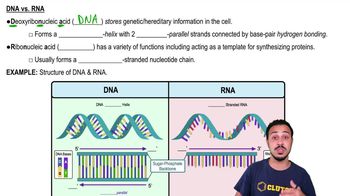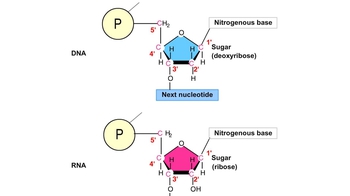Table of contents
- 1. Introduction to Biology2h 42m
- 2. Chemistry3h 40m
- 3. Water1h 26m
- 4. Biomolecules2h 23m
- 5. Cell Components2h 26m
- 6. The Membrane2h 31m
- 7. Energy and Metabolism2h 0m
- 8. Respiration2h 40m
- 9. Photosynthesis2h 49m
- 10. Cell Signaling59m
- 11. Cell Division2h 47m
- 12. Meiosis2h 0m
- 13. Mendelian Genetics4h 44m
- Introduction to Mendel's Experiments7m
- Genotype vs. Phenotype17m
- Punnett Squares13m
- Mendel's Experiments26m
- Mendel's Laws18m
- Monohybrid Crosses19m
- Test Crosses14m
- Dihybrid Crosses20m
- Punnett Square Probability26m
- Incomplete Dominance vs. Codominance20m
- Epistasis7m
- Non-Mendelian Genetics12m
- Pedigrees6m
- Autosomal Inheritance21m
- Sex-Linked Inheritance43m
- X-Inactivation9m
- 14. DNA Synthesis2h 27m
- 15. Gene Expression3h 20m
- 16. Regulation of Expression3h 31m
- Introduction to Regulation of Gene Expression13m
- Prokaryotic Gene Regulation via Operons27m
- The Lac Operon21m
- Glucose's Impact on Lac Operon25m
- The Trp Operon20m
- Review of the Lac Operon & Trp Operon11m
- Introduction to Eukaryotic Gene Regulation9m
- Eukaryotic Chromatin Modifications16m
- Eukaryotic Transcriptional Control22m
- Eukaryotic Post-Transcriptional Regulation28m
- Eukaryotic Post-Translational Regulation13m
- 17. Viruses37m
- 18. Biotechnology2h 58m
- 19. Genomics17m
- 20. Development1h 5m
- 21. Evolution3h 1m
- 22. Evolution of Populations3h 52m
- 23. Speciation1h 37m
- 24. History of Life on Earth2h 6m
- 25. Phylogeny2h 31m
- 26. Prokaryotes4h 59m
- 27. Protists1h 12m
- 28. Plants1h 22m
- 29. Fungi36m
- 30. Overview of Animals34m
- 31. Invertebrates1h 2m
- 32. Vertebrates50m
- 33. Plant Anatomy1h 3m
- 34. Vascular Plant Transport1h 2m
- 35. Soil37m
- 36. Plant Reproduction47m
- 37. Plant Sensation and Response1h 9m
- 38. Animal Form and Function1h 19m
- 39. Digestive System1h 10m
- 40. Circulatory System1h 57m
- 41. Immune System1h 12m
- 42. Osmoregulation and Excretion50m
- 43. Endocrine System1h 4m
- 44. Animal Reproduction1h 2m
- 45. Nervous System1h 55m
- 46. Sensory Systems46m
- 47. Muscle Systems23m
- 48. Ecology3h 11m
- Introduction to Ecology20m
- Biogeography14m
- Earth's Climate Patterns50m
- Introduction to Terrestrial Biomes10m
- Terrestrial Biomes: Near Equator13m
- Terrestrial Biomes: Temperate Regions10m
- Terrestrial Biomes: Northern Regions15m
- Introduction to Aquatic Biomes27m
- Freshwater Aquatic Biomes14m
- Marine Aquatic Biomes13m
- 49. Animal Behavior28m
- 50. Population Ecology3h 41m
- Introduction to Population Ecology28m
- Population Sampling Methods23m
- Life History12m
- Population Demography17m
- Factors Limiting Population Growth14m
- Introduction to Population Growth Models22m
- Linear Population Growth6m
- Exponential Population Growth29m
- Logistic Population Growth32m
- r/K Selection10m
- The Human Population22m
- 51. Community Ecology2h 46m
- Introduction to Community Ecology2m
- Introduction to Community Interactions9m
- Community Interactions: Competition (-/-)38m
- Community Interactions: Exploitation (+/-)23m
- Community Interactions: Mutualism (+/+) & Commensalism (+/0)9m
- Community Structure35m
- Community Dynamics26m
- Geographic Impact on Communities21m
- 52. Ecosystems2h 36m
- 53. Conservation Biology24m
4. Biomolecules
Nucleic Acids
Problem 5`
Textbook Question
Enzymes that break down DNA catalyze the hydrolysis of the covalent bonds that join nucleotides together. What would happen to DNA molecules treated with these enzymes?
a. The two strands of the double helix would separate.
b. The phosphodiester linkages of the polynucleotide backbone would be broken.
c. The pyrimidines would be separated from the deoxyribose sugars.
d. All bases would be separated from the deoxyribose sugars.
 Verified step by step guidance
Verified step by step guidance1
Understand the role of enzymes in biological reactions: Enzymes are biological catalysts that speed up chemical reactions without being consumed in the process. In this case, the enzymes are responsible for breaking down DNA by catalyzing the hydrolysis of covalent bonds.
Identify the structure of DNA: DNA is composed of two strands forming a double helix. Each strand is made up of nucleotides, which consist of a phosphate group, a deoxyribose sugar, and a nitrogenous base (either a purine or pyrimidine).
Focus on the covalent bonds in DNA: The covalent bonds that join nucleotides together are known as phosphodiester linkages. These linkages form the backbone of the DNA strand, connecting the phosphate group of one nucleotide to the deoxyribose sugar of the next nucleotide.
Determine the effect of enzyme action: When enzymes catalyze the hydrolysis of phosphodiester linkages, they break the covalent bonds in the DNA backbone. This results in the fragmentation of the DNA strand into individual nucleotides or smaller nucleotide chains.
Evaluate the options: Given that the enzymes break the phosphodiester linkages, option b is correct. The DNA backbone is disrupted, but the bases remain attached to their respective deoxyribose sugars, ruling out options c and d. The separation of the two strands (option a) involves breaking hydrogen bonds, not covalent bonds.
 Verified video answer for a similar problem:
Verified video answer for a similar problem:This video solution was recommended by our tutors as helpful for the problem above
Video duration:
27sPlay a video:
Was this helpful?
Key Concepts
Here are the essential concepts you must grasp in order to answer the question correctly.
Enzyme Function
Enzymes are biological catalysts that speed up chemical reactions without being consumed in the process. They work by lowering the activation energy required for a reaction, allowing it to proceed more quickly. In the context of DNA, specific enzymes can catalyze the hydrolysis of covalent bonds, breaking down the DNA structure.
Recommended video:
Guided course

Functions of Enzymes
DNA Structure
DNA is composed of two strands forming a double helix, with each strand consisting of a sugar-phosphate backbone and nitrogenous bases. The backbone is formed by phosphodiester linkages between nucleotides, while the bases pair through hydrogen bonds. Understanding this structure is crucial to predicting the effects of enzymatic action on DNA.
Recommended video:
Guided course

Discovering the Structure of DNA
Hydrolysis Reaction
Hydrolysis is a chemical reaction involving the breaking of bonds in molecules using water. In the case of DNA, hydrolysis can break the phosphodiester linkages in the backbone, leading to the separation of nucleotides. This process is essential for understanding how enzymes can degrade DNA by cleaving these covalent bonds.
Recommended video:
Guided course

Chemical Reactions
Related Videos
Related Practice



















